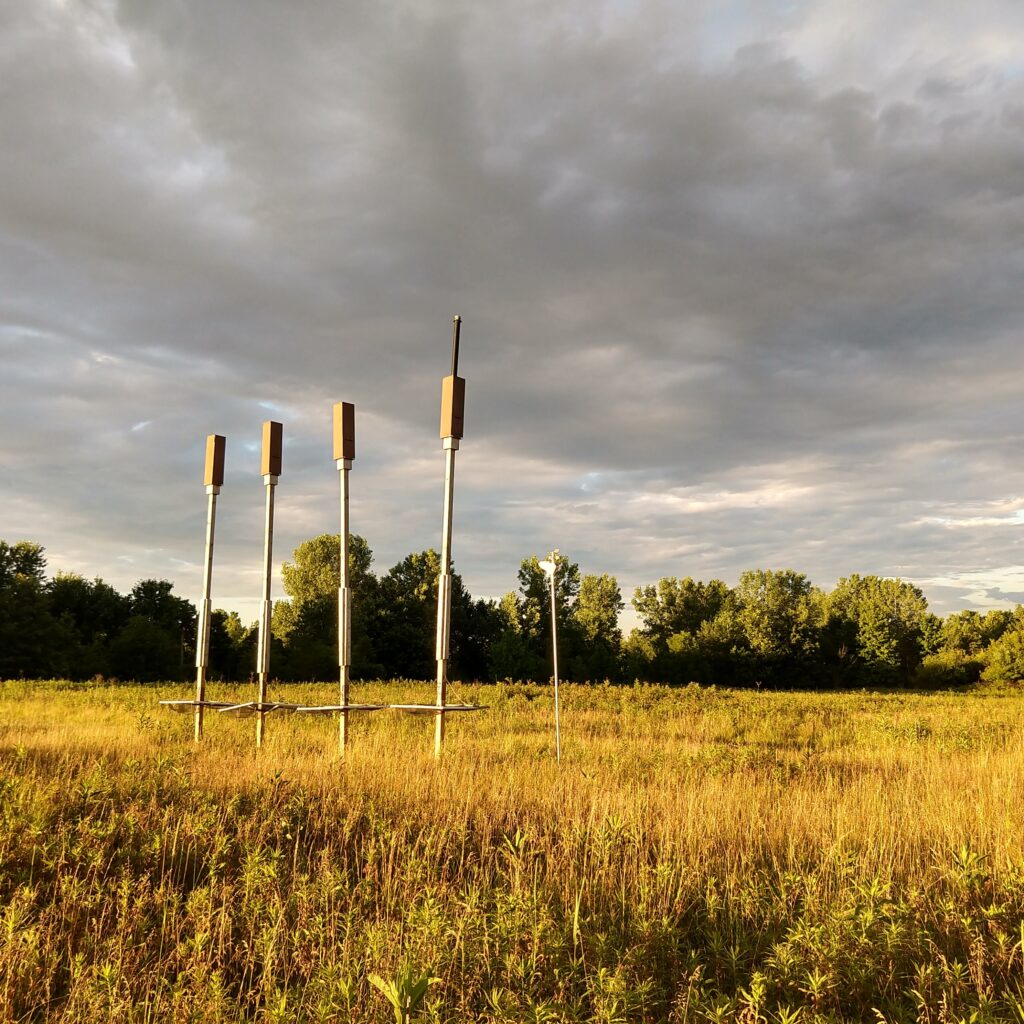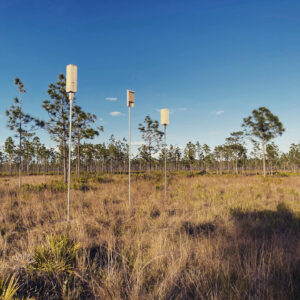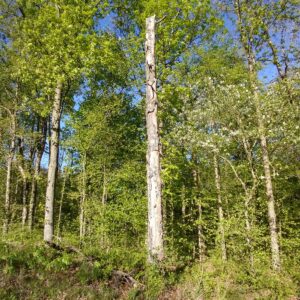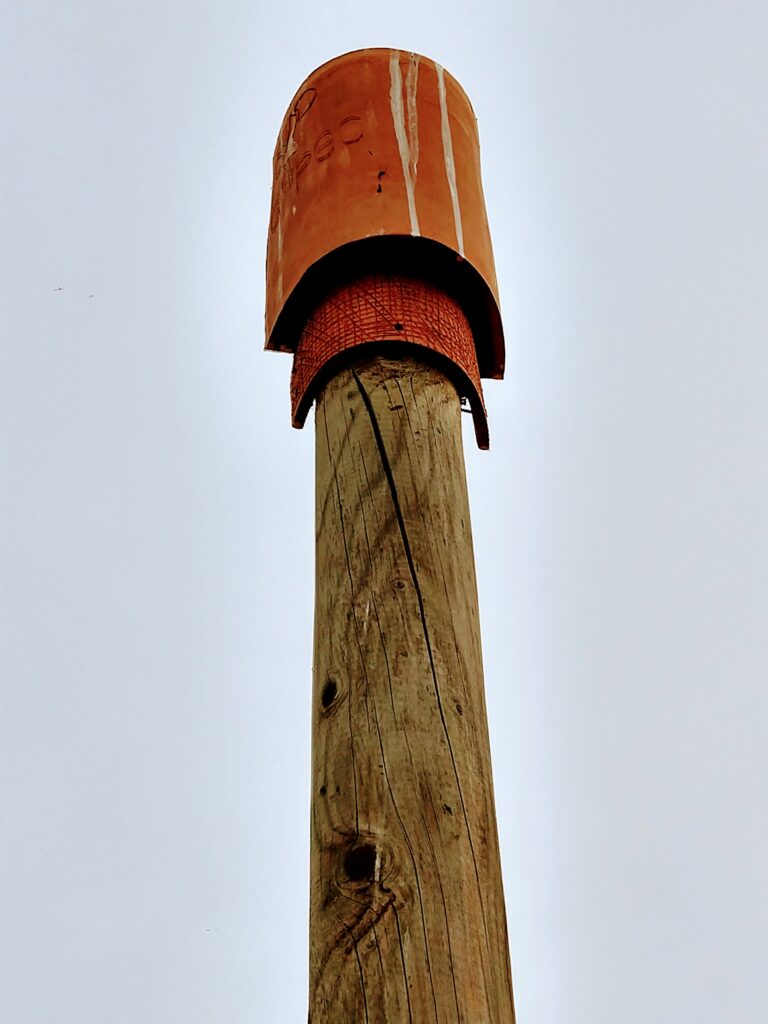
Text on this page by Reed Crawford, with contributions from Joy O’Keefe. Updated in September 2022.
Our lab has been conducting research on artificial bat roosts (e.g., bat boxes or houses) since 2015, with ongoing projects in Illinois, Indiana, Kentucky, Florida, and Minnesota. Increasingly, we are aware of bat mortality in bat boxes that is likely attributable to overheating. For instance, recent work in Australia documented the deaths of 30 juvenile large forest bats from hyperthermia in a dark-green bat box1. Other researchers are also noting the potential dangers of boxes that get too hot and can be dangerous to bats. We published a perspectives paper on the topic of heat stress in bat boxes in the journal Conservation Science and Practice2. On the other hand, we see great potential for enhancing the suitability of artificial roosts for bats via design changes that promote heat retention at night, when developing pups are left alone in the roost. Here, we provide some background and guidance to improve microclimate conditions for bats using artificial roosts.
Artificial roosts and heat stress
Bat boxes and other artificial roosts are commonly deployed to aid bats. However, these increasingly popular conservation tools can pose a risk to bat safety and health in certain environments2. Some bat box designs overheat (internal temperatures >104°F), leading to bats experiencing heat stress or dying1,3–5. When artificial roosts are poorly designed or placed, they may offer less suitable microclimates than the natural tree hollows and crevices to which bats are adapted6–8. Climate change adds another layer of risk to this problem and may compound the risk of heat stress to bats in artificial roosts2,9–10. Unfortunately, there is still much uncertainty about optimal artificial roost design and placement, which will vary by species and landscape2. Below, we provide a list of suggestions and strategies to reduce overheating risk, backed by empirical research, with the goal of improving the safety of artificial bat roosts for bat species worldwide.
Decreasing overheating risk
Artificial roost placement
- High solar exposure can increase artificial roost temperature and overheating risk5,11–12. Because maternal bats typically select solar-exposed artificial roosts over shaded alternatives13–14, we recommend roosts receive some shade during the hottest part of the day. We have had good luck with bats using artificial roosts positioned near tree lines so that they are shaded for part of the day5.
Color
- Avoid dark-colored artificial roosts as dark colors substantially increase overheating9,11 and bats may preferentially select dark artificial roosts12,15–17, which increases the risk.
- We recommend lighter colors like gray or tan, as these absorb less solar radiation and will be cooler, thus decreasing overheating risk11,18. For example, we measured temperatures inside the unpainted boxes pictured below while they were deployed in southern Florida from March to December and rarely observed instances of overheating near the top of one design. In 2021, we initiated a study to understand how boxes with a gradient of colors compare in terms of overheating; we will update this page when those results are known.

Roost type, material, and size
- Small artificial roosts (both in volume and height) with low mass may overheat more readily and not offer bats safety from high temperatures2,6. We recommend tall artificial roosts with four sides (or multiple accessible roost chambers), which will provide large temperature gradients5,18–22 and allow bats to move to avoid high temperatures.
- Larger artificial roosts made of dense materials with low thermal conductance will have a higher thermal mass and thus take longer to heat and overheat5,9,18,20–22.
- Adding extra vents to an artificial roost will reduce overheating risk and make the roost cooler for bats9,20.
- Adding insulating layers (e.g., polystyrene) to the outside of an artificial roost will also reduce temperatures10,22, and could enhance social thermoregulation.
- Adding shading (e.g., large or elevated roof) to an artificial roost will also reduce overheating risk4,20.
Considerations for different bat species
- We recommend larger (in height and volume) artificial roosts for bat species that form large groups. If a larger group forms in a small artificial roost, there will be less room for individual movement and, thus, some bats may be trapped in hot parts of roosts.
- Recent work has shown that thermal tolerance varies by bat species depending on the stability of their natural roost structures. For example, bats that typically roost in caves with stable temperatures may have lower heat tolerances than bats that roost in more variable temperature conditions such as under exfoliating bark23–25. Therefore, it is important to consider life history traits of target species to understand their potential susceptibility to heat stress.
Artificial roosts and energy costs for bats
Bat boxes are typically designed for use by maternity colonies of bats, which usually include tens to hundreds of adult females and their pups. Pregnant and lactating adult females select for warm roosts that offer conditions conducive to fetal development during pregnancy and infant development during the initial few weeks after birth. Adult females leave pups in the roost while they forage at night, which means pups are vulnerable to cool nighttime temperatures. While artificial roosts can be quite warm during the day, most do not retain heat into the night due to a lack of insulation and low thermal mass12,16,20,26. Designing artificial roosts that retain heat later into the night should promote pup development and enhance survival rates. Such artificial roosts should have microclimate conditions more similar to those found in natural roosts—typically cavities and crevices in trees—which are larger and more insulated.
Improving heat retention
Roost size, type, and material
- Increasing roost size – Larger structures, such as bat condos or longer designs, are slower to warm and slower to lose heat, so they will retain heat longer into the night. Another advantage of a large roost is that it will be able to house more bats, which will allow for more social thermoregulation (i.e., many warm bodies warming the roost) during cold spells. Placing any artificial roost in contact with a larger object, such as a building, is another way to increase a roost’s thermal mass22.
- Material/insulation – Choose building materials or insulating layers that increase the thermal mass of the box or that reduce heat convection to the surrounding air9,18,20,22. For example, as described below, adding an insulating water “jacket” to a roost reduces the risk of overheating during the day and slows heat loss at night.
Profile: two-chambered rocket box
Biologists Dan Dourson and John MacGregor first conceived the rocket box design in 1994, with the idea that this roost would mimic the conditions under the sloughing bark of a dead tree, a common roost choice for many forest-dwelling bat species. The rocket box design offers roosting space on four sides with differing solar exposure and bats can choose from cool conditions near the bottom or warm conditions near the top of the ~1-m tall chamber. A rocket box offers a larger temperature gradient and more volume than a traditional flat-fronted box with only one chamber. We build rocket boxes with two chambers and a pass-through hole on each side so that bats can more readily move inside the box. The rocket box attracts Myotis bat species adapted for roosting in tree crevices and cavities19. We rigorously evaluated temperatures in 19 variants of this design to understand how design modifications affect microclimate suitability for occupants20. We learned that vents and a white roof reduce the risk of overheating, as dangerously hot air accumulates near the top of the box without these features. In a temperate climate, even the rocket box design cannot buffer extreme outside temperature, but the water jacket box described below improves on this basic design.
Profile: water-jacket design
A water-jacket box is a rocket box surrounded by an empty wooden jacket which adds a 1.9-cm-wide air space adjacent to the outermost chamber. The jacket contains 12 water-filled packets (28 x 28 x 1.9-cm); each packet is a heat-sealed freezer bag filled with 750 ml of water20. Because of the addition of this outer jacket, the box has no vents. A water jacket can be added to the outside of virtually any box design; however, the efficacy of the water jacket for retaining heat will vary with surface area, volume, color, orientation, and solar exposure of the box.
Following work showing the benefits of heated bat boxes27, we worked with Dr. George Bakken to conceptualize the water-jacket design with the goal of decreasing energy expenditures for roosting bats with high energy demands, such as bats in the early stages of reproduction or those recovering from white-nose syndrome. By increasing the thermal mass of the box with water packets, the water-jacket box reduces the risk of overheating at the top of the box and provides the benefit of warmer nighttime temperatures via phase lag (i.e., heat retention longer into the night). Pups will benefit from the absence of injuriously high daytime temperatures at the top of the boxes. This may be particularly important during heat waves, given the tendency of gravid and lactating mothers and their pups to occupy the warmest part of the box where crowding may impede escape from lethal or injurious conditions16. Our analyses5,20,21 indicate that the extra cost and effort needed to construct the water-jacket rocket box is justified, and suggest it is worth pursuing the development of other bat box designs intended to create thermal phase lag and thus warmer and more stable conditions.
Alternative ways to provide roosts for bats
- Carving hollows in live and dead trees is effective for creating suitable roosting habitat for some bat species28. Further, created tree hollows are more robust to temperature extremes than non-tree roosts26,29–30.
- Retaining and generating dead trees is a viable option to create bat roosting habitat31–32 if the trees don’t pose a safety hazard.

Please take this brief survey
References
1. Griffiths SR. Overheating turns a bat box into a death trap. Pacific Conserv Biol. 2021;28: 97–98. doi:10.1071/PC20083
2. Crawford RD, O’Keefe JM. Avoiding a conservation pitfall: Considering the risks of unsuitably hot bat boxes. Conserv Sci Pract. 2021;3: 2–4. doi:10.1111/csp2.412
3. Flaquer C, Puig-Montserrat X, López-Baucells A, Torre I, Freixas L, Mas M, et al. Could overheating turn bat boxes into death traps? Barbastella. 2014;7: 39–46. doi:10.14709/BarbJ.7.1.2014.08
4. Alcalde JT, Martínez I, Zaldua A, Antón I. Conservation of breeding colonies of cave-dwelling bats using man-made roosts. Barbastella. 2017;10. doi:10.14709/BarbJ.10.1.2017.02
5. Crawford RD, Dodd LE, Tillman FE, O’Keefe JM. Evaluating bat boxes: Design and placement alter bioenergetic costs and overheating risk. Conserv Physiol. 2022;10: 1–14. doi:10.1093/conphys/coac027
6. Rowland JA, Briscoe NJ, Handasyde KA. Comparing the thermal suitability of nest-boxes and tree-hollows for the conservation-management of arboreal marsupials. Biol Conserv. 2017;209: 341–348. doi:10.1016/j.biocon.2017.02.006
7. Strain C, Jones CS, Clarke RH. Spout hollow nest boxes provide a drier and less stable microclimate than natural hollows. Conserv Sci Pract. 2021; e416. doi:10.1111/csp2.416
8. Maziarz M, Broughton RK, Wesołowski T. Microclimate in tree cavities and nest-boxes: Implications for hole-nesting birds. For Ecol Manage. 2017;389: 306–313. doi:10.1016/j.foreco.2017.01.001
9. Martin Bideguren G, López-Baucells A, Puig-Montserrat X, Mas M, Porres X, Flaquer C. Bat boxes and climate change: Testing the risk of over-heating in the Mediterranean region. Biodivers Conserv. 2019;28: 21–25. doi:10.1007/s10531-018-1634-7
10. Larson ER, Eastwood JR, Buchanan KL, Bennett ATD, Berg ML. Nest box design for a changing climate: The value of improved insulation. Ecol Manag Restor. 2018;19: 39–48. doi:10.1111/emr.12292
11. Griffiths SR, Rowland JA, Briscoe NJ, Lentini PE, Handasyde K, Lumsden LF, Robert KA. Surface reflectance drives nest box temperature profiles and thermal suitability for target wildlife. PLoS One. 2017;12: 1–22. doi:10.1371/journal.pone.0176951
12. Kerth G, Weissmann K, König B. Day roost selection in female Bechstein’s bats (Myotis bechsteinii): A field experiment to determine the influence of roost temperature. Oecologia. 2001;126: 1–9. doi:10.1007/s004420000489
13. Brittingham MC, Williams LM. Bat boxes as alternative roosts for displaced bat maternity colonies. Wildl Soc Bull. 2000;28: 197–207. doi:10.2307/4617303
14. Whitaker JO, Sparks DW, Brack V. Use of artificial roost structures by bats at the Indianapolis International Airport. Environ Manage. 2006;38: 28–36. doi:10.1007/s00267-005-0117-2
15. Doty AC, Stawski C, Currie SE, Geiser F. Black or white? Physiological implications of roost colour and choice in a microbat. J Therm Biol. 2016;60: 162–170. doi:10.1016/j.jtherbio.2016.07.015
16. Lourenço SI, Palmeirim JM. Influence of temperature in roost selection by Pipistrellus pygmaeus (Chiroptera): Relevance for the design of bat boxes. Biol Conserv. 2004;119: 237–243. doi:10.1016/j.biocon.2003.11.006
17. Rueegger N, Goldingay RL, Law B, Gonsalves L. Testing multichambered bat box designs in a habitat-offset area in eastern Australia: Influence of material, colour, size and box host. Pacific Conserv Biol. 2020;26: 13–21. doi:10.1071/PC18092
18. Rueegger N. Variation in summer and winter microclimate in multi-chambered bat boxes in eastern Australia: Potential eco-physiological implications for bats. Environments. 2019;6: 1–19. doi:10.3390/environments6020013
19. Hoeh JPS, Bakken GS, Mitchell WA, O’Keefe JM. In artificial roost comparison, bats show preference for rocket box style. PLoS One. 2018;13: 1–16. doi:10.1371/journal.pone.0205701
20. Tillman FE, Bakken GS, O’Keefe JM. Design modifications affect bat box temperatures and suitability as maternity habitat. Ecol Solut Evid. 2021;2: e12112. doi:10.1002/2688-8319.12112
21. Bakken GS, Tillman FE, O’Keefe JM. Methods for assessing artificial thermal refuges: Spatiotemporal analysis more informative than averages. J Therm Biol. 2022. doi:https://doi.org/10.1016/j.jtherbio.2021.103150
22. Fontaine A, Simard A, Dubois B, Dutel J, Elliott KH. Using mounting, orientation, and design to improve bat box thermodynamics in a northern temperate environment. Sci Rep. 2021;11: 7728. doi:10.1038/s41598-021-87327-3
23. Czenze ZJ, Naidoo S, Kotze A, McKechnie AE. Bat thermoregulation in the heat: Limits to evaporative cooling capacity in three southern African bats. J Therm Biol. 2020;89: 102542. doi:10.1016/j.jtherbio.2020.102542
24. Cory Toussaint D, McKechnie AE. Interspecific variation in thermoregulation among three sympatric bats inhabiting a hot, semi-arid environment. J Comp Physiol B Biochem Syst Environ Physiol. 2012;182: 1129–1140. doi:10.1007/s00360-012-0683-6
25. Noakes MJ, McKechnie AE, Brigham RM. Interspecific variation in heat tolerance and evaporative cooling capacity among sympatric temperate-latitude bats. Can J Zool. 2021. doi:10.1139/cjz-2020-0276
26. Griffiths SR, Lentini PE, Semmens K, Watson SJ, Lumsden LF, Robert KA. Chainsaw-carved cavities better mimic the thermal properties of natural tree hollows than nest boxes and log hollows. Forests. 2018;9: 235. doi:https://doi.org/10.1016/j.biocon.2017.04.022
27. Wilcox A, Willis CKR. Energetic benefits of enhanced summer roosting habitat for little brown bats (Myotis lucifugus) recovering from white-nose syndrome. Conserv Physiol. 2016;4: 1–12. doi:10.1093/conphys/cov070
28. Rueegger N. Artificial tree hollow creation for cavity-using wildlife – Trialling an alternative method to that of nest boxes. For Ecol Manage. 2017;405: 404–412. https://doi.org/10.1016/j.foreco.2017.09.062
29. Terry W, Goldingay RL, van der Ree R. Can chainsaw carved hollows provide an effective solution to the loss of natural tree cavities for arboreal mammals? For Ecol Manage. 2021;490: 119122. doi:10.1016/j.foreco.2021.119122
30. Griffiths SR, Robert KA, Jones CS. Chainsaw hollows carved into live trees provide well-insulated supplementary shelters for wildlife during extreme heat. Wildl Res. 2022; 1–14. doi:10.1071/WR21112
31. Timpone JC, Boyles JG, Murray KL, Aubrey DP, Robbins LW, Timpone JC, et al. Overlap in roosting habits of Indiana bats (Myotis sodalis) and Northern bats (Myotis septentrionalis). Am Midl Nat. 2010;163: 115–123.
32. Bergeson SM, O’Keefe JM, Haulton GS. Managed forests provide roosting opportunities for Indiana bats in south-central Indiana. For Ecol Manage. 2018;427: 305–316. doi:10.1016/j.foreco.2018.06.009
